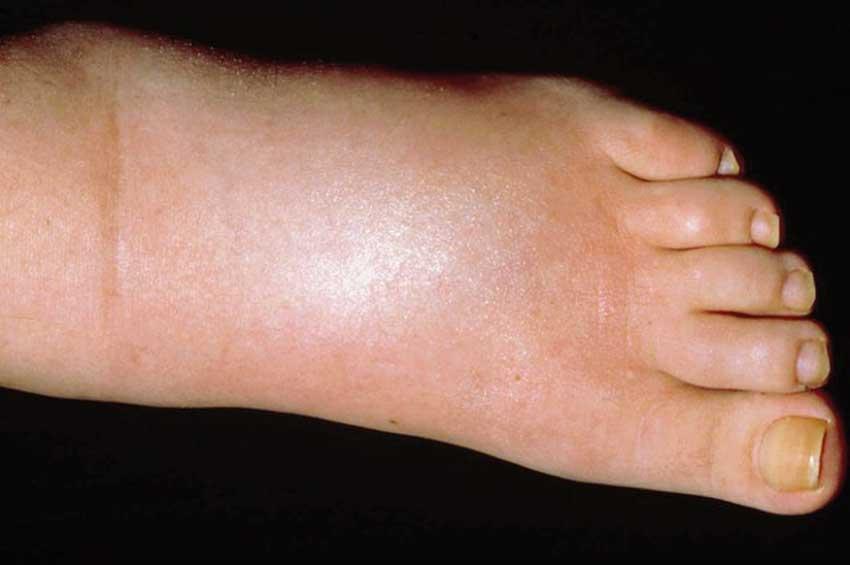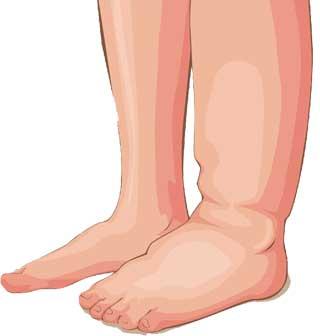30 Apr 2021 - {{hitsCtrl.values.hits}}

 Oedema, (also known as edema) is caused by water retention in tissues. When extra fluid is retained in the spaces between cells in body tissues, the tissues swell up and become oedematous. It can happen anywhere in the body, however, in this case, where fluid is retained in the tissues of the leg, the oedema is termed pedal oedema (swelling of the foot/feet) or peripheral oedema, as limbs are considered peripheral as opposed to the central part of the body which is the trunk.
Oedema, (also known as edema) is caused by water retention in tissues. When extra fluid is retained in the spaces between cells in body tissues, the tissues swell up and become oedematous. It can happen anywhere in the body, however, in this case, where fluid is retained in the tissues of the leg, the oedema is termed pedal oedema (swelling of the foot/feet) or peripheral oedema, as limbs are considered peripheral as opposed to the central part of the body which is the trunk.
There can be multiple factors that contribute to swelling of the lower extremities. Some are physiological causes and some are pathological. Physiological changes are changes in the body that are normal, and acceptable.
Example: Pregnancy and old age. Pathological changes are those that are caused by an injury or illness.
As swelling is a result of water retention, it can be caused by a problem in the systems that are involved in handling and filtering fluid such as the venous circulation system, the lymphatic system, or the kidneys. Long-term kidney disease and acute kidney disease can cause oedema, as the kidneys lose their efficiency to filter blood as they are supposed to.

Congestive Heart Failure (CHF) is also a well-known condition that presents with pedal oedema. As the heart grows weak, the pumping strength is compromised, and the heart fails to pump efficiently. This leads to buildup of blood in the peripheries, especially the lower extremities, and the excess fluid enters the interstitial spaces to cause swelling of the feet.
In CHF, fluid builds up in the lungs as well, causing the patients to experience shortness of breath, as well as a persistent cough. Some patients may even feel bloated and may lose their appetite and feel nauseous. Heart patients must be observant of such symptoms, especially when these symptoms are coupled with oedema in the feet, around ankles, etc.
When a patient presents with one swollen leg, especially swelling around the calf area, accompanied by pain, tenderness and, a warm red appearance, the patient could be suffering from Deep Vein Thrombosis (DVT). Stasis of blood in the lower extremities over time can lead to the development of blood clots. These blood clots can embolize into the bloodstream and could later pass through the lungs, which will result in a life-threatening event called pulmonary embolism. DVT could be caused and aggravated by being seated for too long, in cases of long journeys in the train, airplane, as well as in pregnancy.
One can swollen legs/feet due to fluid buildup simply from being overweight or obese, being inactive, sitting or standing upright for a long period, or wearing “tights” or jeans.Swelling of the feet could also be a side effect of medications. Those with chronic health conditions requiring long-term medications may have pedal oedema as one of the side effects of the many drugs they’ve been prescribed. Ideally, the physician would advise the patient regarding this, upon prescribing such drugs. In cancer patients, it is not uncommon to experience swelling after chemotherapy and radiotherapy.
While pressing the swollen area there may be a dimple like indention or a “pit” that remains for a while in some types of edema. This is called pitting edema. If the tissue returns to its normal shape after being pressed, it’s called non-pitting edema. It is important to differentiate pitting from non-pitting edema to arrive at a diagnosis.
In order to treat the oedema, the underlying cause must be treated. In cases of leg oedema related to congestive heart failure or liver disease can be treated with diuretic medications like furosemide which is commonly known as Lasix. Simply put, diuretics eliminate water from the body via urine and subsequently draw the retained fluid in the feet back into the bloodstream
Limiting dietary salt intake can also help, as more salt attracts more water. Daily fluid intake too must be regulated and monitored in patients with congestive heart failure, following the instructions from their physicians.As for other inflammatory or infectious conditions, where oedema occurs together with p ain and skin changes, immediate medical attention can lead to a quick diagnosis.
21 Dec 2024 33 minute ago
21 Dec 2024 3 hours ago
21 Dec 2024 3 hours ago
21 Dec 2024 4 hours ago
21 Dec 2024 8 hours ago